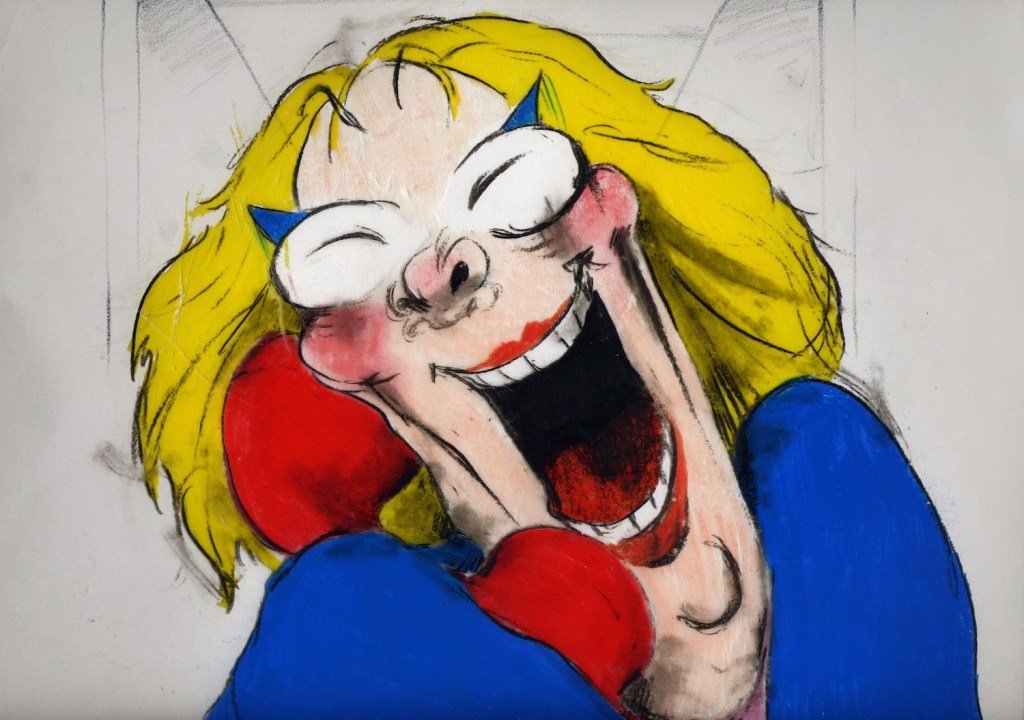Beryl is a quiet housewife who secretly dreams of being whisked away to a desert island by a hunky hero. For her birthday, her rowdy, roistering friends take her on a night out to the local pub, where a spotlight falls onto a male stripper, waggling toned, thonged butt cheeks in her face, and before she knows it, the thong has pinged off and Beryl is a new woman. Played out in jiggling scribbles and bouncing brightness, she’s the lead of Girls Night Out, a short animation that pushes women and their desires firmly to the forefront.
“She’s a real anti-heroine. Everybody thinks she’s just a round, nice mum. But she says, ‘Fuck it, I’m going to be somebody!’” says Beryl’s creator, Joanna Quinn, who made the animation while at Middlesex university in the late ’80s. “At some point during the first year, I realised I felt more comfortable drawing men. Probably because, if you look around, they are always the protagonists. So I challenged myself to draw more women,” Quinn tells Creators. At the time, male strippers were becoming a popular form of entertainment, and she decided to make this the subject of her film, visiting a “very dodgy pub in Elephant and Castle” to see what all the fuss was about, accompanied by friends, who were apparently suddenly very eager to help with her research.
Videos by VICE

Film still, Girls Night Out, 1987. Courtesy Beryl Productions.
“I was really shocked!” Quinn says, of the experience. Instead of shying away from the oiled-up hunk in front of them, the all-female audience were all in the front row, edging their seats closer to get a better look, or helping the performer rub baby oil onto his chest. This atmosphere of unabashed, squealing enjoyment of sexual desire pervades Girls Night Out: Beryl, egged on by her friends, finds herself pinging off the raunchy leopard-print thong of the Adonis in front of her, before returning to her moody, mute husband on the sofa at home. It’s a testament to how free women can be in public spaces when they are given a license to not be objects of desire themselves.
“I didn’t want to make just a cartoon that would be forgotten, full of gags… I started doing research and going to screenings and stuff, and that’s when I realized how many sexist films there were. And it was sort of acceptable because it was a cartoon, so ‘don’t take it seriously!’” This wouldn’t do for Quinn, who remembers the late 80s as a politicized time, with a strong movement against Margaret Thatcher‘s government. The animator name checks feminist magazine Spare Rib as an influence at the time.

Storyboard for Girls Night Out, 1987. Courtesy Beryl Productions.
When the film was finished—voiced in both Welsh language and Welsh-accented English— Girls Night Out began to attract attention from film festivals internationally, winning three prizes at the 1987 Annecy animation film festival. “I suddenly saw where my film fit in (or didn’t)… There were hardly any other feminist films at all. There were some other women filmmakers, but not that many politically feminist,” says Quinn.
Everything in Girls Night Out bounces with subversive, bubbling vivacity. The animation vibrates with its hand-drawn scribbles, making the film immediate and intimate in a way that can often be missing in films with slicker technology—something that has only increased since Quinn has been working in animation. Quinn has tried out tech accessories, such as Cintiq, that streamline her hand-drawn animation process, but has found herself drawn again and again to the tactility of pen and paper. “The physical thing of drawing makes me happy,” she smiles. It’s a shame that, even though it has been 20 years since she drew Beryl, the progress in technology has not been matched by progress in diversity: “The industry has changed completely in terms of technology, but in terms of jobs for women it hasn’t changed at all,” she sighs.

Film still, Girls Night Out, 1987. Courtesy Beryl Productions.
Quinn always intended Beryl to be a feminist anti-hero. Domesticity and motherhood has a difficult place in feminism’s fight for equality: women who choose to remain in the place the patriarchy assigned them are sometimes sidelined. But what Beryl’s fighting spirit illustrates so beautifully is the toughness that women are capable of, even (and especially) those we might write off as being “just” mothers or housewives. “There’s a lot of my mum in her,” Quinn says. “She didn’t look like that at all, but she had that humor and strength, and never moaned about holding down two or three jobs.”
Beryl spawned further films over the years, and the ballsy Cardiff mum evolved from a spectator at a male strip show, to a unionizing factory worker, to an aspiring artist. Quinn has noticed how much women relate to her character. “That’s what animation is good at. People will recognize themselves or a type and then you can twist it. You’ve got your audience hooked. You realize that there are Beryls all over the world!”

Film still, Girls Night Out, 1987. Courtesy Beryl Productions.

Courtesy Beryl Productions.

Learn more about Girls Night Out on Beryl Productions International Ltd’s website.
Related:
This Animation Explaining Why We Itch Will Make You Seriously Itchy
A Sensitive Animated Music Video Tells Women in Abusive Relationships They’re Not Alone
[NSFW] Grace Graupe-Pillard Has Spent a Lifetime Painting Outsiders




